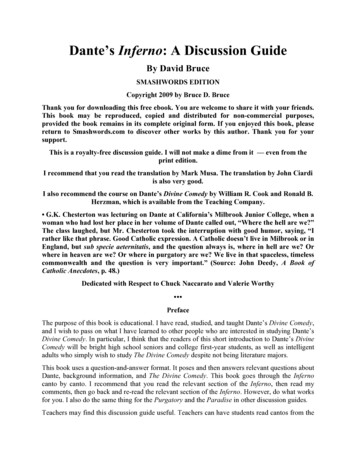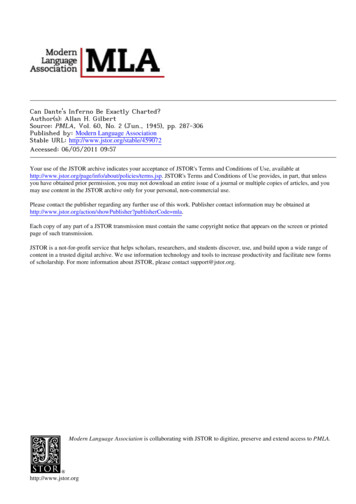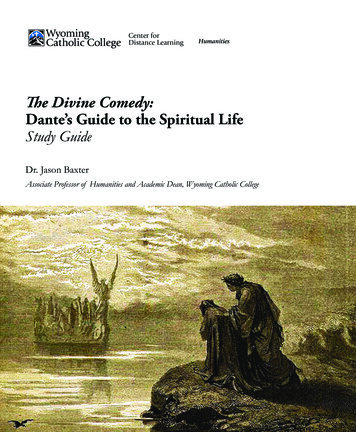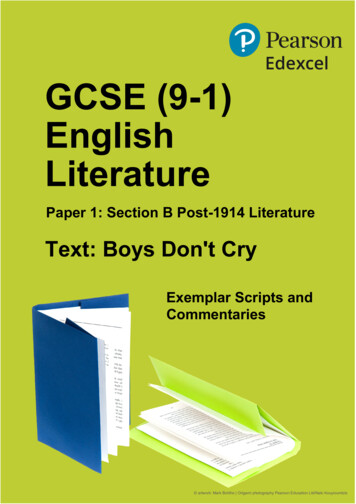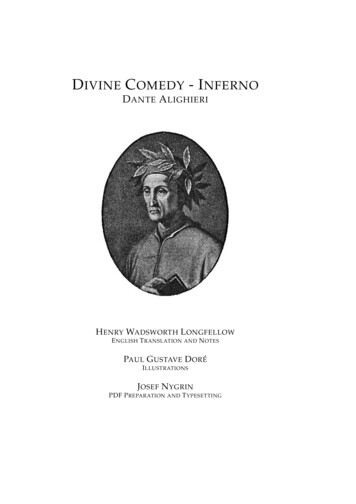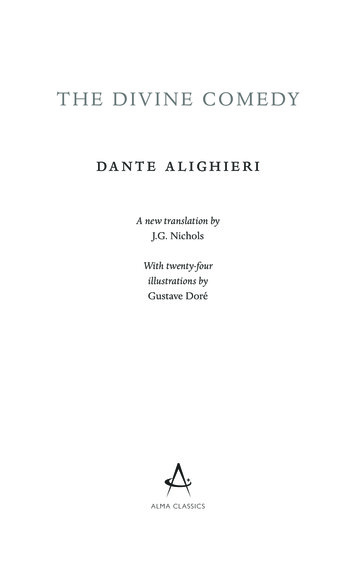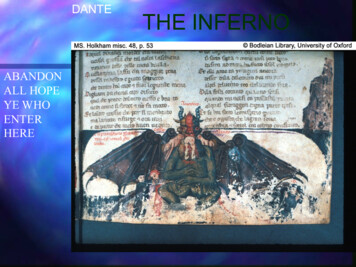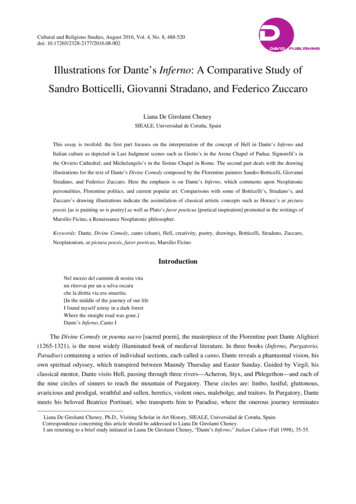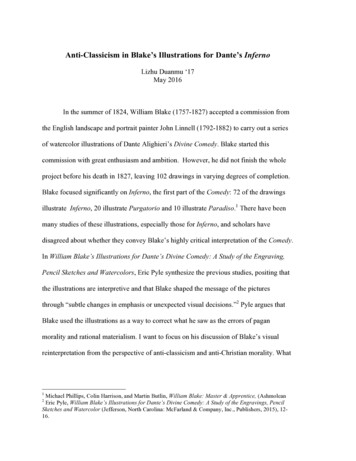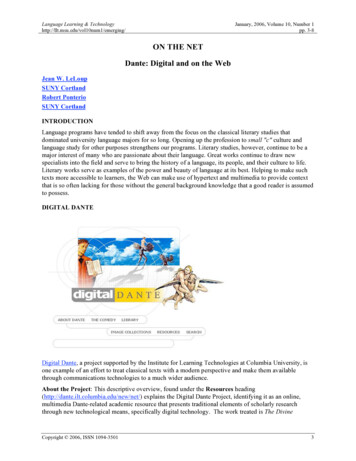
Transcription
Language Learning & nuary, 2006, Volume 10, Number 1pp. 3-8ON THE NETDante: Digital and on the WebJean W. LeLoupSUNY CortlandRobert PonterioSUNY CortlandINTRODUCTIONLanguage programs have tended to shift away from the focus on the classical literary studies thatdominated university language majors for so long. Opening up the profession to small "c" culture andlanguage study for other purposes strengthens our programs. Literary studies, however, continue to be amajor interest of many who are passionate about their language. Great works continue to draw newspecialists into the field and serve to bring the history of a language, its people, and their culture to life.Literary works serve as examples of the power and beauty of language at its best. Helping to make suchtexts more accessible to learners, the Web can make use of hypertext and multimedia to provide contextthat is so often lacking for those without the general background knowledge that a good reader is assumedto possess.DIGITAL DANTEDigital Dante, a project supported by the Institute for Learning Technologies at Columbia University, isone example of an effort to treat classical texts with a modern perspective and make them availablethrough communications technologies to a much wider audience.About the Project: This descriptive overview, found under the Resources heading(http://dante.ilt.columbia.edu/new/net/) explains the Digital Dante Project, identifying it as an online,multimedia Dante-related academic resource that presents traditional elements of scholarly researchthrough new technological means, specifically digital technology. The work treated is The DivineCopyright 2006, ISSN 1094-35013
LeLoup and PonterioDante: Digital and on the WebComedy, and the main translation used for the project is that of Henry Wadsworth Longfellow. Theproject seeks to provide multimedia supplementary materials to those studying the original text, enablingreaders to envision the poet’s meaning in an expanded and multi-dimensional way. By taking advantageof the technologies currently available, this project presents a 21st century illuminated manuscript ofDante’s masterpiece. Indeed, the project is described as a multimedia translation of Dante's text. Thoughthe integration of multimedia is not extensive yet, at the time of this writing, the features of the site thatare already in place are quite interesting for anyone studying Dante.About Dante: Includes a short biography and chronology of Dante’s life. This section also provides linksto Web sites for Dante Studies and Medieval Studies.The Comedy: The project presents The Divine Comedy in its original form, along with translations byLongfellow and also by Allen Mandelbaum. One may chose to view the original with a translation byLongfellow, the original with a translation by Mandelbaum, or both translations together without theoriginal text.Language Learning & Technology4
LeLoup and PonterioDante: Digital and on the WebThis presentation of the translations, one above the other, allows for easy comparison with the original orbetween translations. The texts are annotated with hyperlinks to a text box at the bottom of the page.These notes contain comments about the wording, symbolism, related works, personages, historical notes,etc. This text box can be resized for easier access.There is a second column for annotations, but this does not appear to have any links at the time of thiswriting. We assume that this is intended for the multimedia annotations described in the project overview.This presentation of the Comedy is already a very powerful tool for studying the text. The implementationof HTML frames is a bit inconsistent in this section, causing windows to sometimes appear where theyare not expected or new information to appear in frames where they do not seem to be intended. But thisseems a minor problem.In the Classroom: The General Resources section includes a set of resources for use in the Classroom.Study and research guides, lessons plans, as well as a sample syllabus for a class on Art in the Time ofDante are available here.Language Learning & Technology5
LeLoup and PonterioDante: Digital and on the WebThere is some overlap between sections as the Web Resources and Maps are accessible from multiplelocations in the site. The Web Resources are a lengthy index detailing all hyperlinks on the site.Bibliography: A rather extensive bibliography for Dante studies is offered. It includes scholarly works,translations, and references to selected films and videos.Image Collections: Here one finds images inspired by Dante’s work, reflecting historical and literaryevents. Other images are illustrative of artistic interpretation—both medieval and modern—of the actionand description of The Divine Comedy. In addition, slides from the John Beall collection document,among other things, structures and architecture germane to the time (e.g., Dante’s house in Florence).These images are a rich source for interpretation and discussion of the work itself, as well as the socialand historical background of the times. Maps by various artists give renditions of Dante’s inferno,purgatory, and paradise. The structures of these three places are also given.The Library: This section includes other works by Dante, links to works Dante read and consulted (e.g.,the Aeneid), scholarly references, and some student papers on topics salient to the The Divine Comedy.Language Learning & Technology6
LeLoup and PonterioDante: Digital and on the WebDANTE ALIGHIERI ON THE WEBThis site is another example of an effort to use technology in order to make classical texts available to thepublic and provide a context in which the works can be read and understood. This site, maintained by anindividual rather than being an institutional project, offers information about the poet, Dante Alighieri, hislife, works, and time period. It is a labor of love by Carlo Alberto Furia in the Computer ScienceDepartment at the Politecnico di Milano—which just goes to prove that interest in the humanities iseverywhere. His home page has a running commentary about improvements and additions to his site aswell as suggestions for optimization of browser settings for proper viewing of the pages.The sections on Why Dante?, His time, and Hislife offer a brief justification for the site andcursory background information on the poet andthe history, society, and culture of his time. Theseexplanations are hyperlinked to other sections ofthe site for further information, such as a Glossaryof terms and a geographic map indicating placesmentioned.Language Learning & Technology7
LeLoup and PonterioDante: Digital and on the WebThe section on His work contains links to information about all of Dante’s works. His works in Italian aswell as in Latin are included. All of these texts are available in the Texts Download Area in the followingformats: HTML, RFT, Text only, and PDF and LaTeX source.The Miscellaneous portion of the site contains FAQs, a section on Dante’s Events, information onDante’s burial and the disposition of his corpse, a Quotations page where quotes are grouped by topic, anart gallery with illustrations of The Divine Comedy, and even a page commenting on the connectionbetween Dante and the movie Hannibal, with references to the poet contained therein. In the Audioclipsportion of this section, sound files are available to aid the reader in the proper pronunciation of the titlesof the works.CONCLUSIONThese sites begin as sources of Dante's texts, but they use the power of the Web's multimedia andhypertext features to connect the reader to the background knowledge that contributes so much to theconnection that the authors clearly feel with The Divine Comedy. By sharing this connection with otherreaders, they are not just teaching a text, they are communicating a passion.Language Learning & Technology8
among other things, structures and architecture germane to the time (e.g., Dante's house in Florence). These images are a rich source for interpretation and discussion of the work itself, as well as the social and historical background of the times. Maps by various artists give renditions of Dante's inferno, purgatory, and paradise.

